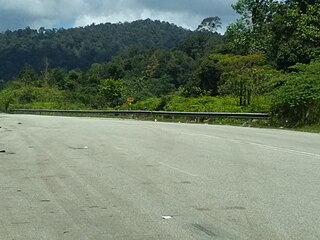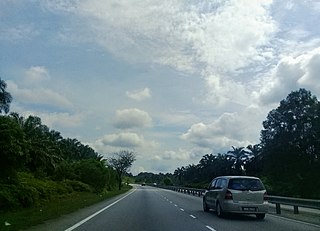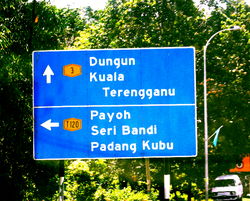
Transportation in Malaysia started to develop during British colonial rule, and the country's transport network is now diverse and developed. Malaysia's road network is extensive, covering 290,099.38 kilometres, including 2,016.05 km of expressways. The main highway of the country extends over 800 km, reaching the Thai border from Singapore. Peninsular Malaysia has an extensive road network, whilst the road system in East Malaysia is not as well-developed. The main modes of transport in Peninsular Malaysia include buses, trains, cars and to an extent, commercial travel on airplanes.

Malaysian State Roads System are the secondary roads in Malaysia with a total length of 247,027.61 km. The construction and maintenance works of state roads in Malaysia is managed by Malaysian Public Works Department (JKR) of each state and funded by state governments. The standard of the state roads is similar with the federal roads except for the coding system, where the codes for state roads begin with state codes followed by route number, for example Johor State Route J32 is labeled as J32. If a state road crosses the state border, the state code will change, for example route B20 in Salak Tinggi, Selangor will change to N20 after crossing the border of Negeri Sembilan to Nilai.

KLIA Expressway, E6 and Federal Route 26, is an expressway in Sepang, Selangor, Malaysia. It serves as the main access road to Kuala Lumpur International Airport (KLIA), as well as the nearby Sepang International Circuit and Bandar Enstek.
North Klang Straits Bypass, Federal Route 20, AH 141, is the main highway bypass to Port Klang in Klang, Selangor, Malaysia. Federal Route 20 became the backbone of the road system linking Sungai Rasau to Port Klang before being surpassed by the New North Klang Straits Bypass 30. Many cargo trucks travel along the highway daily.
Putrajaya–Cyberjaya Expressway, Federal Route 29, is a major expressway in Klang Valley, Malaysia. The 21.2 km (13.2 mi) expressway connects Serdang interchange on Damansara–Puchong Expressway to Kuala Lumpur International Airport (KLIA) in Sepang. It was named after the two sides of the MSC cities, Putrajaya and Cyberjaya.
The Federal Route 2 is a major east–west oriented federal highway in Malaysia. The 276.9 kilometres (172 mi) road connects Port Klang in Selangor to Kuantan Port in Pahang. The Federal Route 2 became the backbone of the road system linking the east and west coasts of Peninsula Malaysia before being surpassed by the East Coast Expressway E8.

KLIA Outer Ring Road(KLIAORR), or Jalan Pekeliling, Federal Route 27, is the second highway and ring road along Kuala Lumpur International Airport (KLIA) after KLIA Expressway (Federal Route 26) in Malaysia. During Formula One Petronas Malaysian Grand Prix championship every year it becomes the main route to Sepang F1 Circuit. From 1 March 2006 until 9 May 2014 it became a main road to Low Cost Carrier Terminal (LCCT).
Federal Route 92, also known as Pengerang Highway, is a federal highway that runs from Kota Tinggi to Sungai Rengit in Johor, Malaysia. The 66.8 km (41.5 mi) highway is also a main route to Desaru beach. Federal Route 92 became the backbone of the road system linking the southeastern Johor before being surpassed by the Senai–Desaru Expressway E22.
Malaysian National Projects are major national and giant projects which are important in the development of Malaysia.

Pan Borneo Highway, also known as Trans-Borneo Highway or Trans-Kalimantan Highway, is a road network on Borneo Island connecting two Malaysian states, Sabah and Sarawak, with Brunei and Kalimantan region in Indonesia. The highway is numbered AH150 in the Asian Highway Network and as Federal Route 1 in Sarawak. In Sabah, the route numbers given are 1, 13 and 22. The highway is a joint project between both governments which started as soon as the formation of Malaysia in 1963 which comprised Malaya, Sabah, Sarawak and Singapore. The lack of a road network system in Sarawak was the main factor of the construction.

Second East–West Highway, also known as Simpang Pulai–Kuala Berang Highway, Federal Route 185 and Federal Route 36, is a highway in Peninsular Malaysia which connects Simpang Pulai in Perak to Kuala Jeneris in Terengganu. It overlaps with Federal Route 8 Federal Route 8 between Gua Musang and Sungai Relau. It is notorious for its many sharp corners which increase the risk of road accidents.

Rail transport in Malaysia consists of heavy rail, light rapid transit (LRT), mass rapid transit (MRT), monorails, airport rail links and a funicular railway line. Heavy rail is mostly used for intercity services and freight transport as well as some urban public transport, while rapid transit rails are used for intracity urban public transport in the capital city of Kuala Lumpur and the surrounding Klang Valley region. There are two airport rail link systems linking Kuala Lumpur with the Kuala Lumpur International Airport and Sultan Abdul Aziz Shah Airport. The longest monorail line in the country is also used for public transport in Kuala Lumpur, while the only funicular railway line is available in Penang.

The KLIA East Road, or Jalan Kuarters KLIA, Federal Route 344, is a fourth highway in Kuala Lumpur International Airport (KLIA) in Malaysia that connects the KLIA Outer Ring Road junctions near Sepang International Circuit in Selangor to KLIA Quarters in Negeri Sembilan. It is also a main route to Sepang and Labu town.
North–South Port Link, or Jalan Kem and Jalan Pelabuhan Utara-Barat, Federal Route 180, is an expressway in Klang District, Selangor, Malaysia. It connects Northport Highway in Port Klang to Teluk Gedong near Pandamaran. The Kilometre Zero of the Federal Route 180 starts at Port Klang.
Transport in Greater Kuala Lumpur includes a road network, a railway network, airports, and other modes of public transport. The Klang Valley is an urban conglomeration consisting of the city of Kuala Lumpur, as well as surrounding towns and cities in the state of Selangor. The Klang Valley has the country's largest airport, the Kuala Lumpur International Airport (KLIA), as well as the country's largest intermodal transport hub and railway station, Kuala Lumpur Sentral.
Northport Highway, alternately Jalan Pelabuhan Utara, Federal Route 103 or Jalan Parang is an expressway in Port Klang, Selangor, Malaysia. It connects Port Klang in the south to Northport in the north.
Jalan KLIA 1, Federal Route 182, is the third highway in Kuala Lumpur International Airport (KLIA), Malaysia. It is a main route to KLIA Charter Field Town or KLIA Town Centre. The Kilometre Zero is located at Nilai-KLIA Highway junctions.

The Malaysian Expressway System is a network of national controlled-access expressways in Malaysia that forms the primary backbone network of Malaysian national highways. The network begins with the Tanjung Malim–Slim River tolled road which was opened to traffic on 16 March 1966, later North–South Expressway (NSE), and is being substantially developed. Malaysian expressways are built by private companies under the supervision of the government highway authority, Malaysian Highway Authority.
The Sarawak section of the Federal Route 1, Asian Highway Route AH 150, also known as Pan Borneo Highway Sarawak or Sarawak First Trunk Road, is a 1077-km federal highway in Sarawak, Malaysia, making the highway as the longest component of the Malaysian portion of the larger Pan Borneo Highway network. Construction of the highway began in 1965 after Sarawak became a member of the federation of Malaysia in 1963.
Jalan Lapangan Terbang Baru Bintulu, or New Bintulu Airport Road, Federal Route 920, is a federal road in Bintulu Division, Sarawak, Malaysia.


 FT 12) runs from Segamat, Johor to Gambang, Pahang.
FT 12) runs from Segamat, Johor to Gambang, Pahang.












